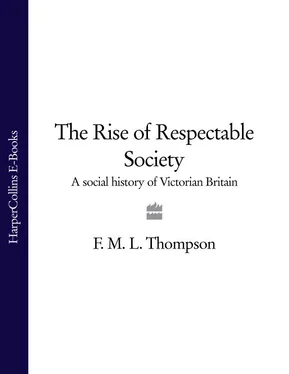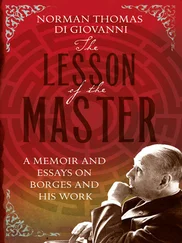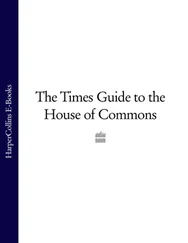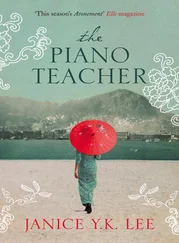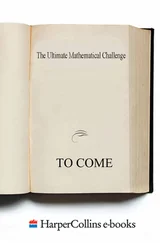It is thus plausible to speculate that middle-class fertility and family sizes were already functioning on a comparatively low level, for a variety of social and economic reasons, before demographic evidence begins to surface that shows they were on a declining trend from the 1860s. This evidence, mainly from the first census of fertility taken in 1911, which recorded information by social and occupational classes from all women then living, supplemented by a few studies using mid-Victorian census enumerators’ books, indicates that middle-class family size had fallen to about 2.8 children by 1911 and had virtually closed any earlier gap there may have been between them and the upper class, since aristocratic families were only slightly smaller, at 2.5 children. Beatrice Webb has been cited as a dramatic illustration of the experience of the late Victorian generation of the wealthy middle classes: born in 1862 as one of the ten children of an industrialist and railway director, her marriage to Sidney in 1892, though it lasted over fifty years, was childless – whether by design or from infertility is not known. A less ambiguous illustration of upper-middle-class habits, if Oswald Mosley’s account is to be trusted, is provided by Margot Asquith, who married in 1894 and had two children (and three stillborn): when she visited Mosley’s wife Cynthia after she had had her first baby, Margot is said to have advised, ‘Dear child, you look very pale and must not have another baby for a long time. Henry always withdrew in time, such a noble man.’ More expertly in bed than in politics, perhaps.
In restricting their families the middle classes were responding to their generally growing prosperity, punctuated by short periods such as in the 1880s when they may have felt retrenchment necessary to cope with economic pressures, and to a fall in child mortality starting in the mid-Victorian years. In brief, middle-class lifestyles were becoming more costly and ambitious, and it seemed more and more desirable to shift family expenditure away from numerous children and towards other things. The central place of domesticity and the family home in middle-class culture in itself implied a larger call on incomes than had previously been devoted to residential needs, and although this central place had already been marked out by the 1830s, the growing availability of creature comforts and domestic conveniences from mid-century – from more elaborate and differentiated furniture and furnishings to bathrooms, from gas lights to family photographs – and the growing attachment to them for reasons of personal comfort or social status, undoubtedly generated insistent pressures for more expenditure on housing and the home. Servant-keeping, a universal middle-class aspiration if not a universally accomplished fact, became more expensive, until by the end of the century domestic servants were probably among the highest paid female workers in the country. Above all, perhaps, the cost of educating middle-class children was increasing, particularly as competitive parental ambition for their children pushed them towards more expensive schools and longer schooling.
The costs of respectability were rising, and one obvious way of affording them was through smaller families. Multiplication of the methods available for achieving smaller families, and wider dissemination of knowledge about them, were occurring at much the same time as the decline in middle-class family sizes; but this coincidence in timing should not be taken as establishing cause and effect. Religious teaching, which consistently held that procreation was the purpose and justification of sexual intercourse and the chief purpose of marriage itself, and that efforts to avoid conception were immoral and sinful, was indeed being weakened at this time both by the self-doubts within the Church over Darwin and by the challenge of the agnosticism or atheism of secularists. The specific birth-control propaganda of the neo-Malthusian secularists, kept alive by George Drysdale in the 1850s with his advocacy of ‘preventive sexual intercourse’ in which ‘precautions are used to prevent impregnation [so that] love would be obtained, without entailing upon us the want of food and leisure, by overcrowding the population’, and by the National Reformer journal in the 1860s, blossomed after the publicity of the Annie Besant – Charles Bradlaugh trial for indecency – for distributing birth-control tracts – and the foundation of the Malthusian Society, in 1877. The championing of women’s rights which had previously been the preserve of a tiny minority easily portrayed as extremist, eccentric, or subversive adherents of Mary Wollstonecraft or Robert Owen, became several shades more respectable when John Stuart Mill cautiously argued in his Principles of Political Economy (1848), and more decidedly in The Subjection of Women (1869), that women should have the same rights as men, and should be relieved of the physical suffering and intolerable privation and drudgery of excessive childbearing. A more direct impact on the ruling class was made by Josephine Butler and her campaign against the Contagious Diseases Acts of 1864 and 1866, which empowered the police to arrest, examine, and regulate suspected prostitutes in specified garrison towns. Her fight, carried on in the name of rights of women to freedom from capricious arrest and to control of their own persons, rather than in the cause of purity and against state-licensed vice, was constantly before the public from 1870 until the suspension of the Acts in 1883; although it was not a campaign about birth control, it was one with obvious connections with the emancipation of women, sex, and women’s control of their own sexual lives.
None of these activists, however, whether secularists, family planners, or feminists, were in the least likely to have made any impression on the country’s birth statistics or on those middle-class circles and middle-class wives among whom family limitation was first practised. The activists were educated men and women in reasonably comfortable circumstances, but they were consciously uttering extremely unconventional and heretical views out of a strong sense of intellectual and moral conviction, views which effectively excluded them from membership of conventional society or acceptance by the majority of their social class. The pioneers of family limitation, on the other hand, were families at the very heart of upper-middle-class Victorian society, guardians of respectability who by no stretch of the imagination could have been the first to succumb to avant-garde influences. They were the families of army and naval officers, accountants, doctors, civil engineers, solicitors, and the non-Anglican ministers. Only the authors and journalists, artists and sculptors, and tobacconists, could be considered outside the pale of unimpeachable respectability – on the ground of association with Bohemian habits, or with trade – among all the groups whose completed family sizes were below the average for the social class to which they belonged (the Registrar-General’s Class I, the upper and upper middle class, for all except the aberrant tobacconists) for all marriages from pre-1861 unions onwards. By the same token, the French letters which a French observer found on sale in Petticoat Lane a little later, in 1883, ‘avec le portrait du ministre Gladstone ou de la reine Victoria’ were not likely to have appealed to these solid family men: they would be, presumably, for the young Conservative or republican market, no doubt mainly aristocratic and wholly unmarried.
The strong probability is that the wives in these upper-middle-class families remained unemancipated, strong or at least unrebellious believers in the dutiful and subordinate role to which their upbringing had conditioned them, and that the initiative in family limitation came from their husbands; or, since the degree of male dominance in Victorian middle-class life may well be exaggerated in the conventional stereotype, that the adoption of family limitation was a strategy discussed and mutually agreed by wife and husband. What does seem certain is that it was not the consequence of any unilateral drive for independence on the part of wives resolved to free themselves from the trials and burdens of unending pregnancies. It is not certain that the particular uppermiddle-class groups which have been specified were in fact the only ones to begin limiting their families from at least the 1850s, since when the Registrar-General placed individual occupational groups into social classes from the 1911 returns he could only draw on occupational information to construct social classifications. It so happened that only some occupations, chiefly in the professions, could be assumed to be wholly middle- or upper-middle-class; other members of the middle class, for instance cotton manufacturers or ironmasters, were returned for census purposes in the industrial grouping to which they belonged and hence could not be distinguished in the fertility survey from the generality of textile workers or ironworkers. Partial information about some groups of businessmen that can be isolated in the census returns does, however, suggest that the commercial and industrial middle classes may indeed have embarked on family limitation distinctly later than the professional groups. Thus, the upper-middle-class groups who entered the band before 1871 were all still from the professions: barristers, Anglican clergy, and those ‘engaged in scientific pursuits’. Those who joined before 1881, however, included bankers, merchants (commodity unspecified), chemists and druggists, who were clearly in the commercial world, as well as dentists, architects, teachers, and law clerks, who were the professional laggards. Colliery owners, moreover, were ten to twenty years behind all these other middle-class groups in opting for smaller families, and at the end of the Victorian period still had larger families than considerable sections of the working classes.
Читать дальше
